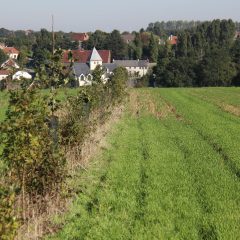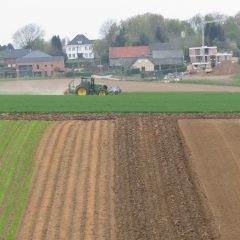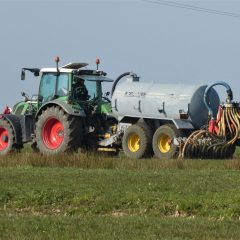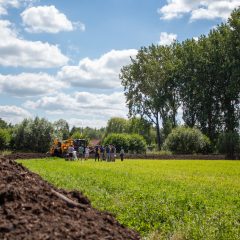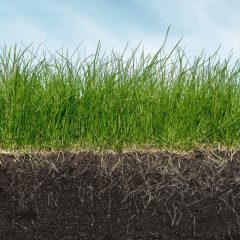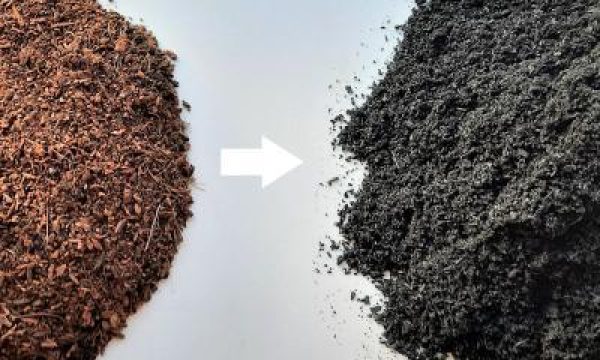Dossier Soil improvement with organic fertilizers
- Soil
- Soil life
- Carbon
- Compost
- Biochar
- Nutrients
- Nitrogen
- Phosphorus
- Non-inversion tillage
- Soil improvement
Soils need a sufficient supply of organic material to improve or maintain soil quality. Organic residues such as crop residues and grass clippings come from agriculture, horticulture and nature reserves. These can be used for soil improvement through various techniques and processes.
What does ILVO do?
-
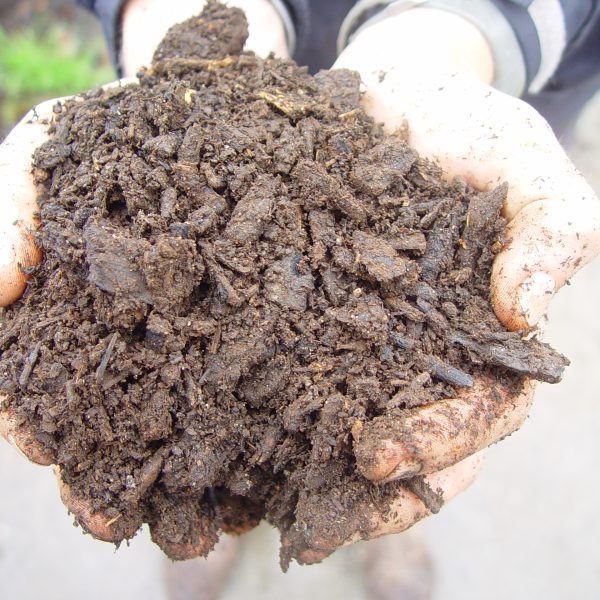 ILVO investigates how organic residue streams can be processed (composting, fermentation,...) before being applied to the soil.
ILVO investigates how organic residue streams can be processed (composting, fermentation,...) before being applied to the soil. -
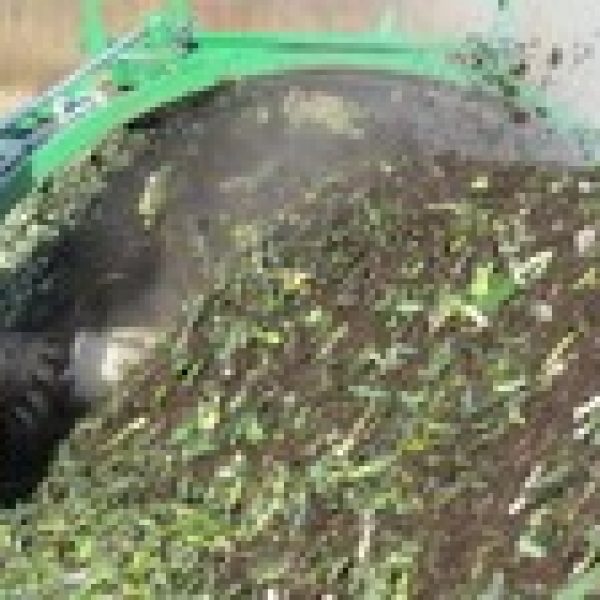 ILVO has its own composting site where the composting process is studied and optimized in detail.
ILVO has its own composting site where the composting process is studied and optimized in detail. -
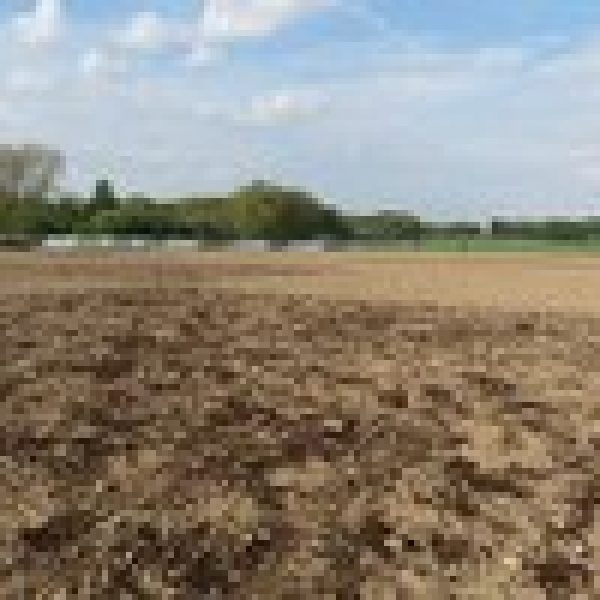 Lab, greenhouse and field trials. ILVO investigates the contribution of organic soil improvers to organic matter, nutrients and biology.
Lab, greenhouse and field trials. ILVO investigates the contribution of organic soil improvers to organic matter, nutrients and biology. -
 ILVO investigates the options and methods for judicious application of organic soil improvers in agriculture and horticulture.
ILVO investigates the options and methods for judicious application of organic soil improvers in agriculture and horticulture.
Organic residual flows
Agricultural systems result in organic residual flows, such as crop and feed residues. Organic residual streams such as grass clippings, heather chippings and shredded wood are also available from natural areas and landscape elements.
These residual flows are interesting to apply to the soil in order to increase soil quality by recycling organic matter and nutrients.
They can be applied alone and unprocessed, but often there is added value by combining materials and processing. ILVO investigates how nutrients and organic matter from waste streams can be recycled to the maximum extent, for the benefit of soil quality and as plant food.
Green management residues
The Bi-o-ptimal@work project investigates how management residues such as heather and pitrus clippings can be used for soil improvement. Cuttings from nature reserves and roadsides generally contain little phosphorus in relation to organic carbon and are therefore interesting for increasing the carbon content of a soil with a limited risk of phosphorus loss. They also bring valuable nutrients and stimulate soil biology.
Green management residues can be used directly as mowing fertilizer. Wood chips can also be applied directly to cropland, but often a problem with nitrogen fixation occurs, resulting in possible nitrogen deficiencies for the crop. Clippings will often contain weed seeds. Therefore, for products such as grass clippings and wood chips, in function of hygiene, stabilization and limitation of nutrient losses, processing by composting and fermentation is rather considered, before they are applied.
Crop residues
Organic residue streams are also created on farms. In addition to animal manure, there are crop residues, such as cleaning waste at vegetable growers and fodder residues at livestock farmers. The untreated "dumping" of these crop residues on plots of land is not good practice because it can lead to uncontrolled nutrient losses and the introduction of pathogens. Again, processing processes such as fermentation and composting can lead to a quality and safer product.
Farm composting
Composting is an aerobic conversion process in which a mixture of green and brown materials is transformed into a stabilized organic soil improver. ILVO researches at its composting site the optimization of the starting mixture, the process course and the conditions during storage.
A farmer does not always have access to both green and brown materials. For good composting, the wet nutrient-rich green materials such as cleaning residues must be combined with drier, more structural and nutrient-poor brown residues. Management residues from natural areas can be used as brown material.
The policy aims to facilitate farm composting in a collaboration between farmers and nature managers, including using an appropriate legal framework. As input for this, ILVO is supervising and documenting a number of example cases.
> More info: Soilcom
Alternative processing
Besides composting, it is also possible to process organic residual flows using other processes.
The residual flows can be ensiled so that a well fermented organic material (bokashi) is obtained via an anaerobic fermentation process.
- Residual flows can also be converted into biogas and digestate through fermentation.
- Through pyrolysis, a heating of biomass at low oxygen availability, biogas and biochar are produced.
- In all these forms of processing, emissions must be limited in the process. The resulting products can be further converted and combined for the preparation of innovative organic commercial fertilizers.
> More info: Rustica research project
Characterization of organic material
The organic residual flows, processed or not into compost, bokashi, digestate, biochar or fertilizer, need to be characterized in order to use them optimally in agriculture. Physical, chemical and biological properties can be analyzed in the ILVO lab for plants, soil and substrate. In the Soilcom project, an overview was made of the most important quality indicators of compost.
Application of organic residue streams as soil improvements
Judicious application of the organic residue streams or their processing products is crucial. Important for this is to know and understand the properties of the materials.
- Mature stabilized compost can be applied throughout the year.
- Residual flows with a higher nitrogen effect are best applied shortly before the start of cultivation.
- Materials that can fix nitrogen are more suitable for autumn, where they can stimulate soil biology before planting or seeding.
Soil improvement properties and effects on crops
Organic materials such as compost, biochar and other (products of) residual flows can contribute positively to soil structure, water balance, soil life and nutrient management. As a result, they can increase the resilience of the cultivation system to climate change and diseases.
ILVO conducts research into the soil improvement potential of various organic products through pot and multi-year field trials.
For further reading:
Contact an expert


